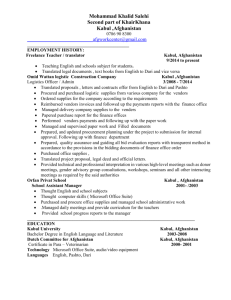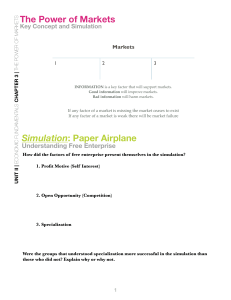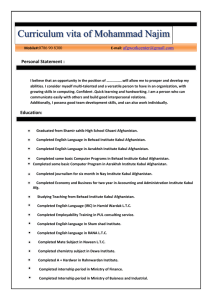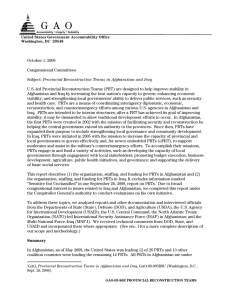Testimony of Dr. William J. Durch
advertisement
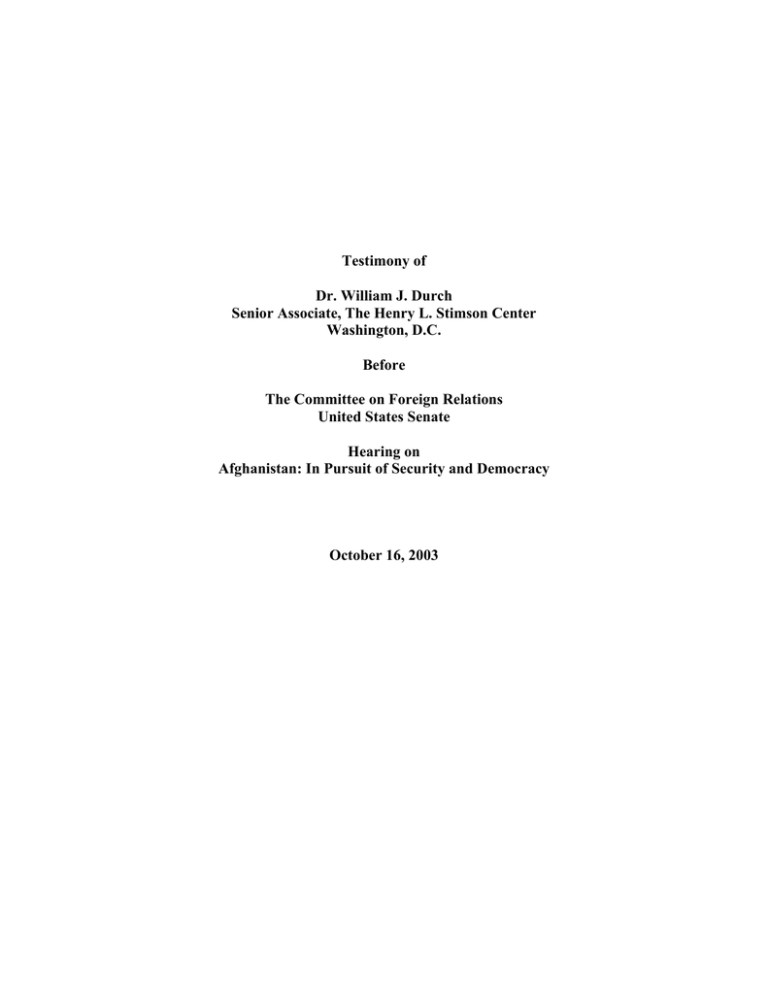
Testimony of Dr. William J. Durch Senior Associate, The Henry L. Stimson Center Washington, D.C. Before The Committee on Foreign Relations United States Senate Hearing on Afghanistan: In Pursuit of Security and Democracy October 16, 2003 Testimony of William J. Durch Mr. Chairman, Members of the Committee, it is an honor to have been invited to testify before the committee on the question of security in Afghanistan and the international community’s potential contributions to it. Since American military operations began just over two years ago, this Committee has been at the forefront of thinking and action, in the best bipartisan tradition, to promote America’s vital interest in post-conflict security and stability in Afghanistan. In these situations we tend to say that “failure is not an option” but it’s still a possibility unless we work very hard to avoid it. The Pashtun-majority half of the country that shares a border with Pakistan is presently so unstable, for example, that civilian aid providers cannot access much of it. The United Nations Security Coordinator has recently declared a substantial part of the South and Southeast off limits to UN personnel. Attacks on US and allied forces and aid providers in this part of the country have accelerated sharply since last spring (see figure 1), as have US and Afghan forces' engagements of Taliban and Taliban supporters. The border with Pakistan is porous and many of the Taliban supporters who cross the border to engage US and Afghan forces are residents of Pakistan's border provinces. Most rocket and mortar attacks against friendly forces since the June 2002 Loya Jirga that launched the present transitional government of Afghanistan have occurred in the Southeast (table 1). Most of the bomb-related incidents, however, have occurred in or near Kabul. The United States has remained engaged in Afghanistan, fighting remnants of al Qaeda and the Taliban and promoting political and economic change, but funding the latter at levels insufficient to promote rapid recovery. The December 2001 Bonn Agreement, however, laid out a schedule for rapid recovery and its most important political milestones are now looming: new constitution, census, voter registration, and elections. The people and the peace process both need protection and, having stressed that such protection needs to be home-grown, the United States and the international community are finally moving to accelerate the training and equipping of Afghan national forces, army and police. Even that accelerated process will not keep pace with the present Bonn timelines, however. Direct international help is required: some combination of expanded presence for the International Security Assistance Force (ISAF) and rapid evolution of the Provincial Reconstruction Team (PRT) concept. I would like to focus my remarks here today on these two security tools. I would like to start, however, by placing Afghanistan in the context of other post-conflict peace operations and the lessons that consistently arise from those operations. Lessons for Afghanistan from other war-to-peace transitions Close examination of more than a dozen other internal conflicts and efforts to help countries make the transition back to a stable peace yields five important lessons: First, local faction leaders’ buyin to the peace process is critical; they must be willing to shift their power struggles from military to political channels and to risk loss of power in elections. Militia leaders who want to cooperate and become politicians within the new governing structure may not agree to demobilize their forces, however, unless some sort of change-to security system is in place that they consider effective and fair. At the moment, there is no "change-to" security structure for most localities in Afghanistan. Ad interim, that role may need to be filled by international peacekeepers, but the Testimony of William J. Durch faster and more effective are the training programs for national forces, the more likely will our friends and allies be to volunteer for such peacekeeping duties because they will be able to see their relief forces already forming. The first lesson is closely tied to the second, that demilitarization of politics is highly desirable before national elections. If factions’ heavy weapons have been cantoned and their military formations demobilized, there is not much they can do to promote a rapid return to warfare. That lesson was bitterly learned in Angola, where more than 300,000 civilians died in a resumption of fighting after elections that the main rebel leader failed to win. In the case of Afghanistan, the most urgent case of demilitarization involves Kabul itself. Only the United States is in a position to press for the demilitarization of Kabul as provided in the Bonn Agreement. It should build barracks for Northern Alliance forces, perhaps at Charikar, between Kabul and the Panjshir Valley, and canton heavy weapons at Bagram Air Base under American supervision. The third lesson is the importance of cutting off would-be spoilers' access to highly portable, highvalue commodities that they can use to fund resistance to the peace process. In Afghanistan, that means getting a handle on the exploding opium poppy crop (3,400 tons of opium gum produced last year and more than 4,000 tons expected this year).1 In the past two years, Afghanistan has resumed its former position as the source of three quarters of the world's heroin, which now feeds half a million addicts in the immediate region and much of Europe's heroin consumption, and funds organized criminal cartels and most likely al Qaeda. Note that, unlike Iraq’s main marketable resource, Afghan heroin is self-aggrandizing (that is, if outsiders and the government do nothing to hinder it, the market takes off, generates a narco-criminal economy, provides resources for fundamentalist and terrorist organizations, and causes major damage locally, regionally, and globally). The fourth lesson is the need to get neighboring states to support the peace process in Afghanistan. If they play local favorites, look away as contraband crosses their borders or take a cut from that commerce, peace and legitimate government in Afghanistan most likely will not survive. Fifth, the great powers, and the United States in particular, need to stay engaged in the peace process. Such engagement does not guarantee success—the record of difficult transitions with great power engagement is mixed—but the historical record elsewhere suggests that, without it, Afghanistan’s transition from war to peace is almost certain to fail.2 Implementing Peace in Afghanistan: the role of ISAF and the PRTs The International Security Assistance Force (ISAF), now under NATO command, and the Provincial Reconstruction Team (PRT) concept are the primary quick impact tools at the disposal 1 United Nations Office on Drugs and Crime, Global Illicit Drug Trends 2003 (Vienna, Austria: UNODC, March 2003), pp. 170-180. Owais Tohid, “Bumper year for Afghan Poppies,” Christian Science Monitor, July 24, 2003. 2 For complete discussion see Stephen John Stedman, Donald Rothchild and Elizabeth M. Cousens, Ending Civil Wars (Boulder, Colo.: Lynne Rienner Publishers, 2002), pp. 1-66. Testimony of William J. Durch of the international community for helping the Afghan government provide security in key locales during this critical transitional period, while national security forces are trained. ISAF Expansion The Afghan government, the UN Assistance Mission in Afghanistan (UNAMA), and most of the NGO aid providers in the country have advocated expansion of ISAF beyond Kabul since early 2002. In spring 2002, to counter speculation that such expansion would necessarily entail several hundred thousand troops, and to give the ISAF debate some reasonable analytical underpinnings, my project at the Stimson Center drafted a concept of operations that replicated ISAF-Kabul in seven other cities, taking into account their population and security situation relative to Kabul. We briefed the results to key offices in the Departments of State and Defense, to congressional staff, and to NGOs, and have posted them on the web, with periodic updates. The concept calls for an increase in ISAF personnel from the present 5,000 to just over 17,000 troops (for results of the latest update, see figure 2 and tables 2 and 3). Some of these troops (about 2,700) would provide security in cities where UNAMA has its regional offices and the initial PRTs have been deployed. Note that each of these urban areas of operation would be fairly circumscribed, drawn to encompass the town, its adjoining airport, and a modest buffer zone, amounting to 1,000-1,500 square kilometers. The majority of expanded ISAF forces (8-9,000 air and ground forces) would provide security for the repair and use of the roads linking those cities together. The numbers needed for this task were derived from standard NATO models for protecting lines of communication, with added air support for surveillance and rapid reaction. As national forces come on line, the US/international contribution to this task could increasingly revert to tactical air cover and intelligence (helicopter mobility and reinforcement, helicopter reconnaissance, Unmanned Aerial Vehicle [UAV] surveillance assets). Expanded ISAF should operate jointly, to the extent possible, with the Afghan national army and the Interior Ministry’s highway patrol force, and with the Afghan national police, and hand off responsibility to those forces as they gain numbers and experience. In mid-2002, the US government lifted its objections to the expansion of ISAF; in August 2003, NATO formally assumed command of the force; and, on Monday, the UN Security Council unanimously agreed to expand its mandate to permit operations outside Kabul. It is now up to the North Atlantic Council to do so. Germany would like to send 450 troops to the northeastern city of Kunduz, where the UN's pilot militia demobilization and disarmament effort, the Afghanistan New Beginnings Program, is slated to start soon. It would prefer that deployment be under the aegis of NATO and the UN mandate for ISAF. PRT Command and Control Since Germany has also agreed to staff the Kunduz PRT, this raises an interesting question of command and control. Should the PRTs remain under the command of Operation Enduring Freedom (OEF) or should they perhaps transfer to ISAF, now that NATO provides a standing framework for ISAF planning and operations? What will better facilitate tie-ins to central government development plans, to UNAMA, to the training and equipping of Afghan security Testimony of William J. Durch forces, and to the extension of the central government’s authority, in fact and in perception? As the PRTs in the northern tier of the country internationalize (British in Mazar, New Zealanders in Bamiyan, Germans in Kunduz), are they better viewed as extensions of OEF or as elements of a separate post-conflict peacekeeping and reconstruction effort? Because the PRT concept has been presented as highly adaptive to local conditions, I would suggest that PRTs outside the areas of greatest insecurity—that is, outside the South, Southeast, and East—work under NATO/ISAF but that PRTs in the three most dangerous regions continue to work for OEF, because a single chain of command can be crucial where combat is a daily risk. NATO and OEF should be able to work out cross-support arrangements for NATO’s PRTs, although if the force structure sketched above were to be implemented, ISAF could provide its own cross-support in most circumstances. PRT Needs and Priorities The PRTs’ primary goals are local reassurance and extension of central government influence. They can and should also be a trellis for growing a greater security presence, both international and local. There is debate about the details of their functions, however. The relief and development community wants and needs security providers, not competing provision of assistance, but they themselves may or may not be seen locally as acting in the name of the Afghan government—as opposed to their home government, agency, or organization. PRT planners and commanders argue that they can and do act on behalf of the central government, although it is not clear how local actors actually credit PRT activities—as support from the central government or from Washington. I sympathize with both sets of arguments, make just two points: First, to the extent that the PRTs civilianize, with development experts, agronomists, veterinarians, and the like, then whatever capacity they have for providing security—which averages one or two platoons of troops per PRT—will necessarily be directed to force protection and not community security. Second, if ISAF does expand as suggested, its forces can assume the principal community security burdens in their defined areas of operation. The PRTs can usefully emphasize two sets of activities in any case: networking and support of law enforcement infrastructure. PRT commanders need top-notch communications, not only for reachback to OEF in dangerous circumstances but to promote communications within their areas of operations. That means satellite phones for use by the governor and his district officials, in the absence of landlines or commercial cellular service (which will appear as soon as security is good enough to protect its relay towers). It means building structures that civilian aid providers are reluctant or unable to build: courts, jails, and police stations for use by the officers trained at the new facilities to be co-located with several PRTs. To facilitate their work, the PRTs also should be given better ground mobility and spending authority. Equip them with Humvees instead of commercial 4X4s. Give them some air assets (small Unmanned Aerial Vehicles would be ideal). Give them discretionary spending authority up to some ceiling amount, say, $25,000 per project. The PRTs and their officers are the cutting edge of US influence at the local level and the avatars of the central government. Since we trust them with the job, we should trust them with the money to do the job, provided what they do is Testimony of William J. Durch consistent with the Kabul government’s development objectives. Finally, each PRT should have a public affairs officer to keep the public and local government informed of what they are doing and where they are headed. Consider giving each a radio broadcast capacity—shortwave or FM as indicated by terrain and local listening habits. Give them each a small, dedicated engineering team, if reconstruction is to remain in their portfolios.3 Rebuilding Afghanistan’s security sector The 18 month old training program for the Afghan National Army (ANA) will have produced ten battalions, about 6,000 professional troops, by the end of 2003 and aims to have another 3,000 trained by mid-2004 when national elections are presently scheduled. The national goal, set last year at the “Bonn II” meeting, is 70,000 soldiers. If training is accelerated, as proposed by the Administration, to around 10,000 recruits per year, the nominal force goal will be reached in 2010. There is welcome acceleration of police training of all types in the Administration’s plans. Police training courses are designed to last about 16 weeks, meaning that each of eight training centers co-located with a PRT should be able to train between 1,500 and 2,700 police candidates per year (at 750-900 officer candidates per class). The justification for the supplemental suggests a breakout of 18,000 national police, 4,000 border police, and 2,600 highway patrol officers trained annually. These rates will meet government goals for police staffing by 2006 and provide a baseline force to help secure Afghanistan’s electoral process. That process must get underway soon in preparation for the scheduled June elections, however. By late winter 2004, the training program may have graduated its first class, assuming that the facilities can be set up at breakneck speed this fall. So we are looking at perhaps 6,000 newly trained national police to secure a census (in a country where ethnic background matters a great deal and the last census predates the civil war) and voter registration; and perhaps 12,000 by next summer to secure the election (including protection for candidates, voters, voting places, and integrity of ballot boxes and vote counts). Localities may therefore have to rely in large part on local security forces and it is very important that these forces, and those who pay them, work on the side of transitional government. While the acceleration of police training is needed and welcome, the amount of money proposed to rebuild the other institutions of law enforcement and criminal justice seems rather meager. Funds requested for rule of law ($10 million) amount to 36 cents per Afghan, yet Afghanistan’s formal justice system is essentially nonexistent. The request for elections and governance support amounts to roughly $2.75 per potential voter (using U.S. Census Bureau population estimates).4 By contrast, the supplemental requests roughly $125,000 per expatriate technical adviser. Such advice may be needed but compares rather unfavorably with the roughly $1,300 per year that AID pays its national hires or the $840/year that we plan to pay national police and soldiers to provide vital security services. 3 I am grateful for a number of these ideas and observations to Lt. Col. Christopher Allen, former commander of the Gardez PRT. Cited with permission. 4 U.S. Census Bureau, “IDB Summary Demographic Data for Afghanistan,” available online at: www.census.gov/cgibin/ipc/idbsum?cty=AF. Testimony of William J. Durch Indeed, in the current supplemental request, 5% less reconstruction funding for Iraq could more than double the amount of new money available for reconstruction in Afghanistan. Stability in Afghanistan is a vital interest of the United States. Since time is money and we do not have all the time in the world to achieve stability, we better use money. Testimony of William J. Durch Table 1: Summary Data: Stimson Center Afghanistan Security Incidents Database, June 2002 through August 2003 Kabul Area East South East South West North Central Highland North East Row Totals: 40 12 28 19 3 2 3 4 111 Light Arms 5 1 9 4 1 0 2 0 22 Rockets, Artillery, Mortars 9 8 10 7 2 1 1 1 39 26 3 9 8 0 1 0 3 50 50 33 54 52 11 16 0 7 223 20 8 23 36 5 13 0 0 105 9 14 23 7 3 2 0 0 58 21 11 8 9 3 1 0 7 60 Caches Discovered Bombs and Mines Incident Frequency Light Arms Rockets, Artillery, Mortars Bombs and Mines Sources: International wire services (via Lexis/Nexis); United Nations Office for the Coordination of Humanitarian Affairs (OCHA), Relief Web: Afghanistan (www.reliefweb.int); monthly reports of the British Agencies Afghanistan Group (BAAG). Testimony of William J. Durch Fig. 1: Security Incidents in Afghanistan, Over Time 30 Cumulative Frequency 25 20 East, Southeast, South Other regions Kabul Area 15 10 5 Ju n 1- 15 , Ju 02 ly 1 Au -15 g Se 1-1 pt 5 1 O -15 ct 1 N -15 ov 1 D -15 e Ja c 1 n 1- 15 15 Fe , 03 b 1 M -15 ar 1 Ap -15 r1 M -15 a Ju y 1 n 1- -15 15 , Ju 03 l1 Au -15 g 115 0 Semi-monthly data, June 2002-August 2003 Testimony of William J. Durch Fig. 2: Protecting Afghanistan’s Main Roads and Border Crossings Length of road link, in kilometers. Companies of mobile infantry needed to guard road links in Testimony of William J. Durch Table 2: Data for Calculating ISAF Expansion UN areas of responsibility (AOR): Capital East South West North Gardez Kandahar Herat Mazar-e Sharif Bamiyan Kunduz 1,000 1,000 1,500 1,200 1,200 1,000 1,000 0.05 0.01 0.16 0.12 0.09 0.04 0.08 UNAMA regional offices: Kabul Jalalabad ISAF-Kabul AOR and proposed new AORs (sq. 1,720 km.) City populations relative to Kabul (fractions) 1.00 Principle threats Indicated in UNSYG's report of 18 March 2002: Central Highland North East South East Regional threat indices relative to Kabul for each threat type (rounded). Al Qaeda/Taliban remnants 1.00 1.50 1.60 1.20 0.80 0.70 0.60 0.80 Political/factional violence 1.00 1.00 1.00 0.80 0.80 1.10 0.70 0.70 Other violent crime 1.00 1.30 1.10 1.10 0.90 1.10 0.90 1.00 Testimony of William J. Durch Table 3: Estimated Troop Levels Needed to Expand ISAF into Key Cities/Towns, While Protecting Main Road Links between Garrisons, and to Borders UN Areas of Responsibility (AOR): Capital UNAMA offices and PRTs Garrison forces, based on AOR threat level and population relative to Kabul As above, with onebattalion minimum in high-threat AORs Infantry, sized by relative threat and relative population; one-batallion minimum in high-threat areas Infantry, sized by relative threat and relative size of AOR (baseline for next row; adds Bagram into baseline force calculus) For area-based sizing: Ratio of city population to Kabul 5,000 East South East South Jalalabad Gardez Kandahar Central Highland North East Mazar-e Sharif Bamiyan Kunduz West North Herat Totals, all areas: 280 120 760 530 510 150 320 7,670 900 900 900 476 900 133 277 4,487 900 900 0 953 992 267 554 4,566 2,964 2,773 3,672 2,671 3,774 2,125 2,125 20,104 5,000 900 900 1,333 953 992 267 554 5,899 142 23 4 29 66 35 24 51 Testimony of William J. Durch infantry, medium option (ISAF + OEF) Highway security and border crossing forces Force totals: 520 610 360 1,830 2,060 2,010 300 1,160 8,850 5,520 890 480 2,590 2,590 2,520 450 1,480 16,520


